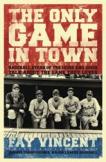In Their Own Words
For most people, spring means warm weather, the return of birds and the flowering of nature. For serious baseball fans, it means spring training, the anticipation of a new season and time to read a book about the game. A good choice would be former baseball Commissioner Fay Vincent’s opening volume of the Baseball Oral History Project. Inspired by Lawrence Ritter’s The Glory of Their Times, an oral history of men who played at the turn of the century, Vincent picks up the story in the 1930’s and 1940’s as he interviews 10 stars of those days. They are all elderly now, and this volume makes sure that their stories get told and saved. Baseball lifers of a certain age will find it not only a satisfying journey back to their own early memories of the game but also a stimulus to compare the games and the players of those times and our own.
The 10 stars, most of them enshrined in the Hall of Fame, bring to life a memorable, transitional period in the history of the game, the years before and after World War II. The most significant development was the transforming of the sport into a truly national pastime by the coming of Jackie Robinson. The rocky but successful process of racial integration, and its impact on players and fans, is a thread that runs through the entire book. The story has been told many times, but now we hear it through the personal recollections of 10 men who earn our admiration not only for their athletic accomplishments but also for the largeness of their hearts. Three black players—Buck O’Neill, Larry Doby and Monte Irvin—experienced segregation and contributed to progress at personal cost; they also offer memories and insights into the world of Satchel Paige, Josh Gibson and other luminaries of Negro League baseball. Bob Feller and others who barnstormed with Paige and his teammates knew early on that the game was being diminished by their exclusion, and rejoiced at the coming, better late than never, of the new era.
Apart from the drama of racial integration, one is tempted to remember those times as almost idyllic in their simplicity and integrity. Those were the good old days before steroids and strikes, when there was no reason to challenge the authenticity of records and other accomplishments. And in many ways there was a genuine purity of effort and commitment by players in general. But, as one of my history teachers used to say, the good old days were not so good. Black players were not the only victims of harassment; Hank Greenberg’s being Jewish brought out some more of the ethnic intolerance and insensitivity typical of that era. Ballplayers had no leverage in seeking fair wages; there was no labor union, and stars and understudies alike had only two choices: accept the terms offered, or don’t play at all. There were no player agents, either; some today might call that addition by subtraction, except for the deplorable fact that there was nothing to negotiate.
The men we hear from in this book engage in fascinating comparisons between the eras. Tommy Henrich believes that today’s players are bigger, stronger and faster, but so intent on the money that they don’t put all their best on the field. Warren Spahn, who pitched 63 shutouts and completed 382 of his 665 starts, wonders why today’s pitchers receive raves for being able to get through six or seven innings. Bob Feller, who pitched 36 complete games in 1946, criticizes their conditioning. This book may not appeal to the set-up men and closers who make millions today for their ability to bail out tired starters.
Reading the recollections and analyses of these old-time greats, however, leaves no doubt that we are all talking about the same basic game. The required ability to hit, throw and run, and the demands of hand-eye coordination are still the same; that is part of the game’s appeal. What have changed are game management and strategy. Players like Ralph Kiner, Johnny Pesky and Dom DiMaggio would do just as well, and maybe better, today. They would certainly have become much wealthier. But none of them complain about being born before the age of millionaire .250 hitters.
One of the most delightful features of this book is the character of the men who speak to us in their straightforward way about how much the sport meant to them. They all see themselves as blessed with God-given talent and fortunate to be able to make a good living playing a game they loved. They didn’t ignore the limitations of their times then, and they don’t deny them now. But in retrospect they see a flawed human enterprise that had so many good things for players and fans alike that the faults can be forgiven.
Like any good book about sports, this one is filled with great stories, most of which are true. Twice-told tales about colorful characters and memorable events are recounted by different players from different perspectives, but always by those who were involved and close to the action. Who was a better manager, Casey Stengel or Leo Durocher? Did Babe Ruth actually call that home run shot? Did Whitey Ford keep tying his shoes so that he could grease the ball? Was Johnny Pesky really to blame for letting Enos Slaughter score the run that won the 1946 series? Check it out.
This article also appeared in print, under the headline “In Their Own Words,” in the April 3, 2006, issue.








